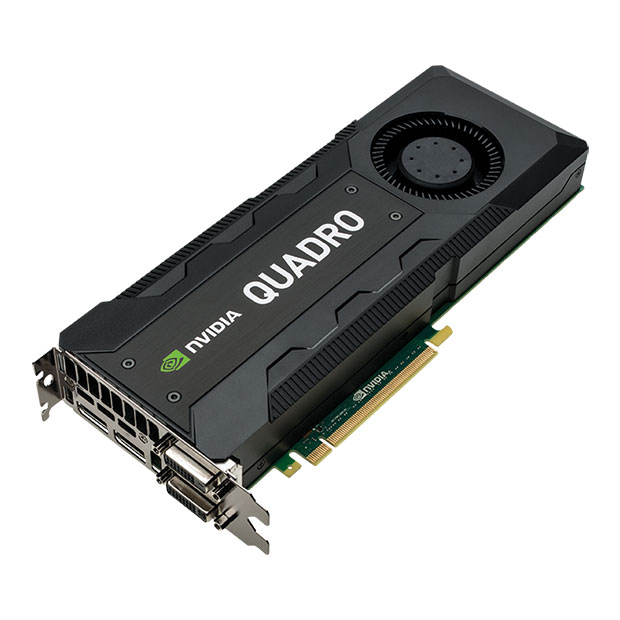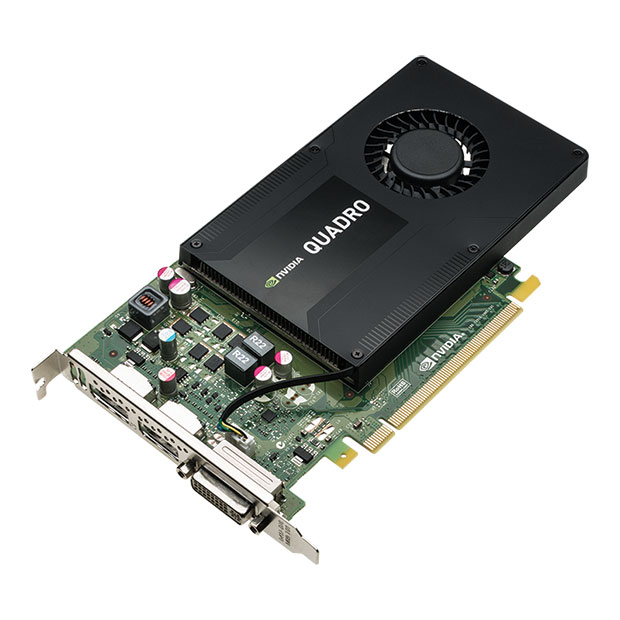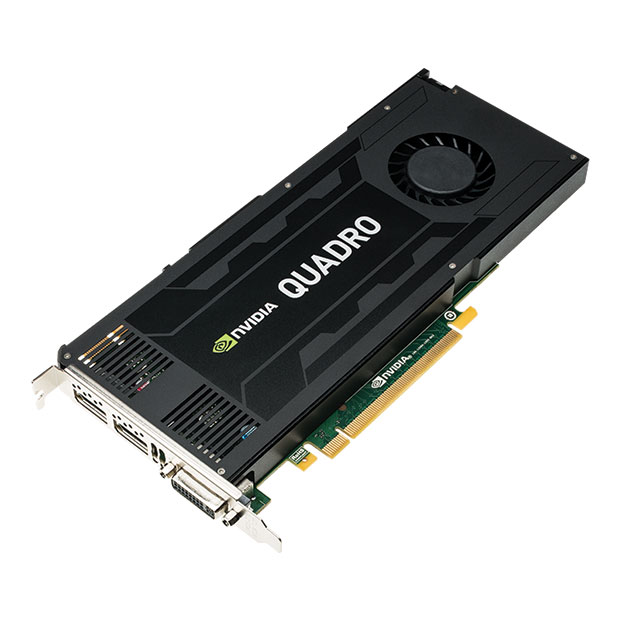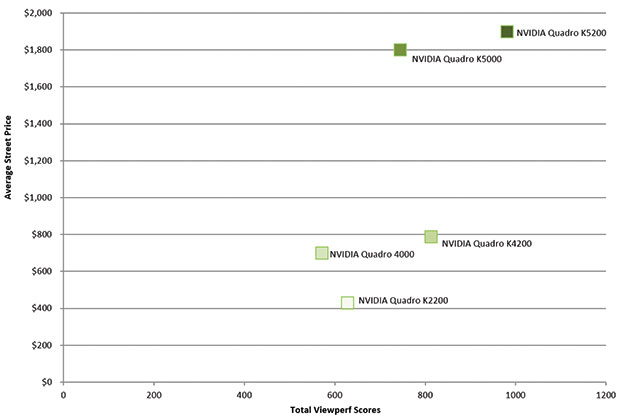Review: NVIDIA’s Impressive New GPUs

The ultra high-end Quadro K5200. Image courtesy of NVIDIA.
Latest News
June 1, 2015
It’s been several years since we last looked at workstation-class graphics accelerators from NVIDIA. At that time, we reviewed two impressive (and expensive) graphics boards, the high-end Quadro K5000—the first board based on the company’s Kepler-based GPU (graphics processing unit)—and the ultra-high-end Quadro 6000 board.
This past August, at the SIGGRAPH conference in Vancouver, Canada, NVIDIA unveiled its next generation of Quadro GPUs with the introduction of the K5200, K4200, K2200, K620 and K420. The new boards began shipping in the fall of 2014. Offering up to twice the application performance and data-handling capability of the previous generation, the Kepler-based boards let users interact with their designs locally on a workstation or remotely with a Quadro-based workstation from essentially any device, including PCs, Macs or tablets.
We subjected three of the new Quadro boards—the K5200, K4200 and K2200—to a battery of tests. We also installed several of the previous generation GPUs in the same BOXX APEXX 2 workstation so we could compare the new generation to the old, seeing for ourselves whether NVIDIA’s claims of performance improvement held up.
NVIDIA Quadro K2200
The NVIDIA Quadro K2200 is the company’s new mid-range graphics solution, replacing the K2000. This GPU delivers exceptional power-efficient 3D application performance. Yet with a suggested retail price (MSRP) of $599 and a selling price around $429, the K2200 delivers a lot of bang for the buck. The Quadro K2200 features 640 CUDA (compute unified device architecture) parallel processing cores (compared to 384 in the K2000) and includes 4GB of GDDR5 memory, double that of its predecessor. Its 80GB/second memory bandwidth is also considerably greater than the K2000. In addition, an all-new display engine drives up to four displays with DisplayPort 1.2 support for ultra-high resolutions up to 3,840x2,160 at 60Hz with 30-bit color.
The K designation in this board’s name is a bit misleading. The K2200 (as well as the entry-level K620 board) is actually based on NVIDIA’s next-generation Maxwell GPU architecture—as is the recently announced NVIDIA M6000 board. The reason for the change is really one of timing, with the company having to base its release cycle on both its own internal development and releases from Intel and major workstation vendors.
NVIDIA claims floating point performance of 1.3 TFLOPs single precision and 40 GFLOPs double precision. The K2200 has a 128-bit memory interface.
Like its predecessor, the Quadro K2200 provides a dual link DVI connector as well as two DisplayPort 1.2 connectors, and supports up to three monitors using its available connectors or four via a DisplayPort hub. The board uses a single PCIe x16 slot and with a maximum power consumption of 60 watts, the K2200 does not require any additional power connections.
NVIDIA Quadro K4200
The high-end NVIDIA Quadro K4200 is the next step up in price and performance. Because it uses the same chip found in the K5000, it offers a substantial improvement over the previous generation K4000. Yet, with an MSRP of $1,249 and an average purchase price of $789, it is a bit more expensive than its predecessor.
The Quadro K4200 provides 1,344 CUDA cores (compared to 768 in the K4000) and includes 4GB of on-board GDDR5 memory (compared to 3GB in the K4000). Its 256-bit memory interface is also wider than the 192-bit interface in the older board and its 173GB/sec bandwidth is also greater than the 134GB/sec of the K4000.
Floating point performance is nearly double that of its predecessor: 2.1 TFLOPs single precision (compared to 1.2 TFLOPs for the K4000) and 90 GFLOPs double precision.
Again, like its predecessor, the Quadro K4200 provides a dual link DVI connector as well as two DisplayPort 1.2 connectors and supports resolutions up to 3,840x2,160 at 60Hz. You can connect up to three monitors using the on-board ports, or four via a DisplayPort hub. The K4200 uses a single PCIe x16 slot, but its maximum power consumption of 105 watts requires an additional 6-pin auxiliary power connector. The K4200 also supports an optional 3-pin stereo connector on a separate bracket, and the board is compatible with NVIDIA’s Quadro Sync so you can combine several boards to create a video wall.
NVIDIA Quadro K5200
With an MSRP of $2,499 and an average purchase price of $1,699, the new Quadro K5200 is quite an investment. It uses the same chip as last year’s ultra-high-end K6000. As a result, the K5200 features 2,304 CUDA parallel processing cores (compared to 1,536 in the K5000) and 8GB of GDDR5 memory, double that of its predecessor. And like the K5000, the K5200 uses ECC memory, offering protection of data in memory.
The new board features the same 256-bit memory interface as its predecessor, but increases the memory bandwidth from 173GB/sec to 192GB/sec for a significant performance improvement. NVIDIA claims floating point performance of 3.0 TFLOPs single precision (compared to 2.2 TFLOPs for the K5000) and 130 GFLOPs double precision.
The Quadro K5200 supports a maximum resolution of 4,096x2,160 at 60Hz. Video outputs include two DVI connectors as well as a pair of DisplayPort 1.2 connectors, so you can connect up to four monitors to the card. You can use NVIDIA’s Mosaic technology to create a video wall of up to 16 monitors. An option is a 3-pin stereo connector on a separate bracket as well as framelock/genlock using an optional Quadro Sync card.
The NVIDIA Quadro K5200 consumes two expansion slots, and requires a 6-pin auxiliary power connection to satisfy its 150 watt maximum power consumption.
Benchmarking the Boards
We tested all three new NVIDIA Quadro GPUs, as well as two previous generation boards in a BOXX Technologies APEXX 2 workstation with a 4GHz Intel Core i7-4790K quad core CPU (over-clocked to 4.5GHz) and 16GB of 1,600MHz memory. We performed all tests running the 64-bit version of Windows 7 and using the same version 347.88 NVIDIA video driver on versions 11 and 12 of the SPEC Viewperf video benchmark.
Based on our results, each of the new generation Quadro GPUs clearly outperformed its predecessor. In fact, each new board equaled or exceeded the performance of the next higher level of the previous generation. For example, the performance of the NVIDIA Quadro K2200 equaled or exceeded the benchmark results of the K4000, and the K4200 beat the older K5000. Essentially, a new mid-range board should yield performance equal or better than what you would obtain from a one-year-old high-end board for a lot less money.
Of course, like all other NVIDIA Quadro boards, the Quadro K5200, K4200 and K2200 are fully certified with most CAD and DCC applications and all of the boards in the Quadro line use the same unified video driver.
The latest NVIDIA Quadro GPUs deliver an unprecedented level of performance. The last time we looked at graphics boards, we wondered when the Kepler GPU technology would become available in the company’s midrange boards. With the introduction of the Maxwell technology in the K2200 and the recently released M6000, we will now wait and see when that even newer technology finds its way into the rest of the NVIDIA Quadro line.
More Info
NVIDIA K-Series Specifications
| NVIDIA K5200 NEW! | NVIDIA K5000 | NVIDIA K4200 NEW! | NVIDIA K4000 | NVIDIA K2200 NEW! | |
| Manufacturer’s Price | $2,499 | $2,249 | $1,249 | $1,199 | $599 |
| Average Street Price | $1,899 | $1,800 | $789 | $699 | $429 |
| SPECviewperf 11.0 (@ 1920x1200) | |||||
| catia-03 | 130.69 | 87.52 | 111.61 | 54.08 | 65.18 |
| ensight-04 | 140.72 | 77.51 | 89.32 | 46.98 | 52.65 |
| lightwave-01 | 107.51 | 106.89 | 106.52 | 107.12 | 107.66 |
| maya-03 | 239.42 | 190.23 | 200.50 | 144.66 | 171.09 |
| proe-05 | 29.06 | 28.85 | 28.81 | 29.14 | 29.29 |
| SW-02 | 96.34 | 90.63 | 92.90 | 79.73 | 86.78 |
| tcvis-02 | 105.72 | 81.52 | 90.64 | 56.54 | 57.22 |
| snx-01 | 131.97 | 81.30 | 92.63 | 53.13 | 58.26 |
| SPECviewperf 12.0 (@ 1920x1200) | |||||
| catia-04 | 104.25 | 65.58 | 72.14 | 39.48 | 47.75 |
| creo-01 | 79.58 | 52.36 | 57.97 | 36.07 | 42.53 |
| energy-01 | 3.76 | 2.93 | 3.02 | 0.65 | 3.26 |
| maya-04 | 76.88 | 53.85 | 58.86 | 33.62 | 38.66 |
| medical-01 | 31.13 | 21.73 | 22.70 | 12.65 | 15.14 |
| showcase-01 | 50.57 | 35.85 | 38.64 | 22.94 | 22.63 |
| snx-02 | 83.74 | 57.87 | 65.15 | 37.50 | 34.29 |
| sw-03 | 134.35 | 105.42 | 108.77 | 75.56 | 90.98 |
| SPECIFICATIONS | |||||
| Bus architecture | PCI Express X16 | PCI Express X16 | PCI Express X16 | PCI Express X16 | PCI Express X16 |
| Extra power required | Yes | Yes | Yes | Yes | No |
| Form factor | 4.376 x 10.5 in. | 4.38 x 10.5 in. | 4.376 x 9.5 in. | 4.376 x 9.5 in. | 4.376 x 7.97 in. |
| Slots used | 2 | 2 | 1 | 1 | 1 |
| Max power (watts) | 150W | 122W | 108W | 80W | 60W |
| PCIe version | 3.0 | 2.0 | 2.0 | 2.0 | 2.0 |
| Length | full-length | full-length | 3/4-length | 3/4-length | 1/2-length |
| Processors | 2304 | 1536 | 1344 | 768 | 640 |
| Memory configuration | 8GB (GDDR5) | 4GB (GDDR5) | 4GB (GDDR5) | 3GB (GDDR5) | 4GB (GDDR5) |
| Memory interface | 256-bit | 256-bit | 256-bit | 192-bit | 128-bit |
| Memory bandwidth | 192 GB/sec | 173 GB/sec | 173 GB/sec | 134 GB/sec | 80 GB/sec |
| Number of DVI Dual Link Outputs | 2 | 1 | 1 | 1 | 1 |
| Number of Display Port Outputs | 2 | 2 | 2 | 2 | 2 |
| Stereo 3D Connector (3-pin) | Yes (2) | Yes (2) | Yes (2) | Yes (2) | No |
| SDI-enabled | Yes | Yes | Yes | Yes | No |
| Framelock/Genlock | Yes (1) | Yes (1) | Yes (1) | No | No |
| SLI | Yes | Yes | Yes | No | No |
| OpenGL version | 4.5 | 4.3 | 4.5 | 4.4 | 4.5 |
| DirectX/Shader model | 12/5.0 | 11/5.0 | 12/5.0 | 11/5.0 | 12/5.0 |
| Maximum Resolution Support (@ 60Hz) | 4096 x 2160 (3)2560 x 1600 (4)1920 x 1200 (5) | 3840 x 2160 (3)2560 x 1600 (4)1920 x 1200 (5) | 3840 x 2160 (3)2560 x 1600 (4)1920 x 1200 (5) | 3840 x 2160 (3)2560 x 1600 (4)1920 x 1200 (5) | 3840 x 2160 (3)2560 x 1600 (4)1920 x 1200 (5) |
Subscribe to our FREE magazine, FREE email newsletters or both!
Latest News
About the Author
David Cohn is a consultant and technical writer based in Bellingham, WA, and has been benchmarking PCs since 1984. He is a Contributing Editor to Digital Engineering, the former senior content manager at 4D Technologies, and the author of more than a dozen books. Email at [email protected] or visit his website at www.dscohn.com.
Follow DE









